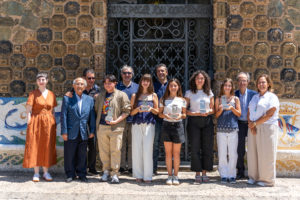July 31, 2023
By: Ferran Garcés
In a publication from 1896, “Barcelona a la vista. Álbum de fotografías de la capital y sus alrededores” (Barcelona in Sight. Album of photographs of the capital and its surroundings), we can read: “Today, from the historic castle of Bellesguart, hardly anything remains except the name, written on a heap of ruins, which will undoubtedly have completely disappeared in a few years” (1). The image at the header is from this book. The author is Fernando Rus, the photographer of the book.
Fortunately, such a sorrowful prophecy did not come true. Thanks to Antoni Gaudí, not only do those ruins still exist, but the current tower allows us to evoke its vanished splendor. Now, how was that castle? The most valuable description, if not the only one, is found in a chronicle called “Descripción de las excelencias de la muy insigne ciudad de Barcelona” (Description of the Excellences of the Very Illustrious City of Barcelona). The author, Dionís Jeroni de Jorba, was a humanist who combined the profession of a jurist with the vocation for literature, becoming one of the first historians of the city of Barcelona (2). His work was published in 1589, that is, almost two centuries after the death of the builder of the castle, Martí I el Humano, in 1410. In it, we read: “A castle named Belesguart, formerly owned by the Kings of Aragon and now owned by Joan Cassador Cavallero, which is surrounded by its walls and towers: there is a beautiful house for a steward, a large courtyard, a fountain and cistern, a very beautiful orchard, and a porch with columns and emblems of the Kings of Aragon, a chapel, two galleries with twenty-four windows, from where you can see Barcelona and the sea, an armory hall, a prison, chapel, clock, and it is a very healthy place.”
Next, we reproduce the royal tower of Bellesguard, as depicted in an artistic approximation made by Jorge Egea (3).
Palace and garden
Apart from this description, very little is known about Martí I’s last residence. The other available documentation consists of some of the letters written by the monarch (4). From them, we know that the king repeatedly requested the sending of stained glass windows and a priest for the castle’s chapel. However, most of the references allude to the “very beautiful orchard” mentioned by Dionís Jeroni de Jorba.
Indeed, through these letters, we know that the king repeatedly asked the procurator of Mallorca to send a couple of slaves to work in the orchard and garden of his new palace. To the Commander General of Caspe, he entrusted the sending of grapevines, and to various royal officials, he sent requests for plants and grafts of fruit trees (5).
As Bellesguard was the palace where Martí I married Margarida de Prades in 1409, the wedding had to take place in the orchard mentioned in the king’s letters. Jacinto Verdaguer, a poet and friend of the architect, evoked that wedding in “La Custòdia,” a poem written in 1900, the year in which Gaudí began the construction of the current tower (6).
Currently, the Bellesguard Tower, surrounded by a small crenellated wall, also has a built-up area and a splendid garden, so the guided or audioguided visit allows us to feel, in a way, as if we were in the time of King Martí. In next week’s article, we will talk about the interior of this castle…
Notes:
(1) Guibernau, J.F., (1910), “Barcelona a la vista. Álbum de fotografías de la capital y sus alrededores,” published by Antonio López, Libreria Española, Barcelona. The original edition is from 1896, but this copy is very difficult to find. On the internet, the 1910 edition is commonly available.
(2) Dionís Jeroni de Jorba, “Descripción de las excelencias de la muy insigne ciudad de Barcelona.” Publicaciones Abella, Madrid, 1988 (original edition, 1589).
Summary: Galindo, Esteban (2018), “El cronista Dionís Jeroni Jorba,” www.diarieljardi.cat (link)
Reproduced in the book of Vall i Comaposada, Josep M., “Bellesguard. De la residencia de Martí el Humano a la Torre de Gaudí,” Duxelm editorial, Barcelona, p. 44
(4) Ibíd, Annex, p. 143-149
(5) Ibíd, p. 51-52.
(6) More poems by Verdaguer about Bellesguard can be found in our blog entry, “El jardí de Bellesguard,” 16/04/2019: link




